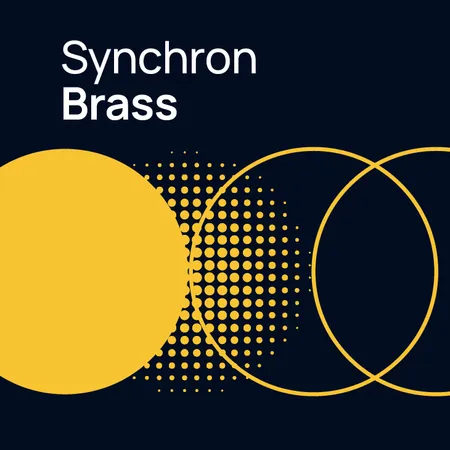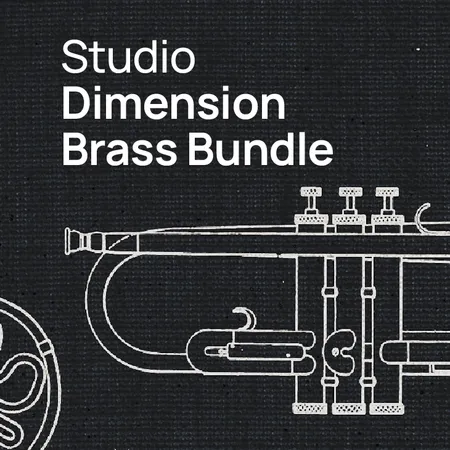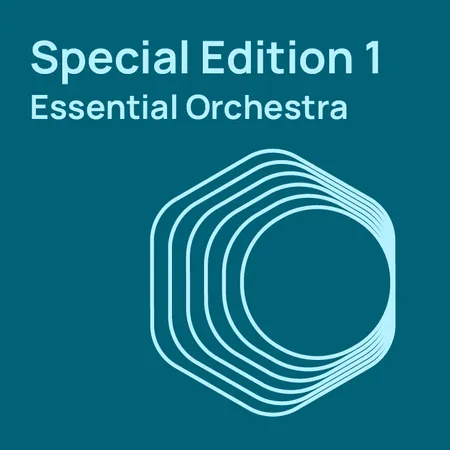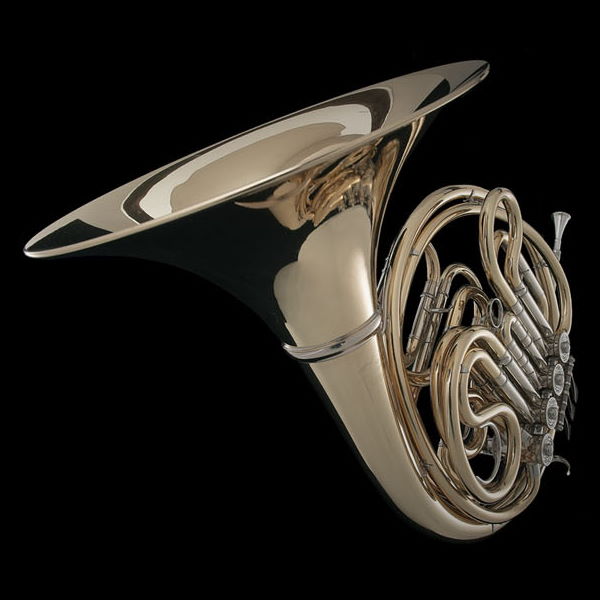
Name: Viennese horn
Spelling
German: Wiener Horn in F
French: Cor Viennois
Italian: Corno di Vienna
Classification: Aerophone, brass wind instrument
Material: Brass, gold brass, nickel silver
Mouthpiece: Funnel-shaped mouthpiece
Tubing: Length 3.7 m, coiled several times, predominantly conical, detachable F crook, length 105-120 cm
Bore: Narrow, inner diameter in cylindrical tubing approx. 10.8 mm
Valves: Three Vienna valves
Bell: Rim diameter 30.5 cm, widely flared and parabolically curved
The tubing of the Viennese horn is 55% conical and narrower than the most commonly used double horn in F/Bb. The so-called F crook is not a fixed part of the Viennese horn but is detachable. Other tunings are used especially for natural horn parts.
The three valves are Viennese valves (twin-piston valves) and are operated by the 2nd, 3rd and 4th fingers of the left hand. In contrast to the Vienna horn the double horn in F/Bb has rotary valves with an optional additional stopping valve. The higher pitch that results from stopping on the Viennese horn is not compensated for by a stopping valve but by playing the note a half tone lower.
By placing his hand in the bell the player can make very subtle adjustments to the intonation. This intonation check, called stopping, is also what produces the typically soft and romantic sound of the French horn. Intonation can also be controlled by means of the embouchure (altering lip tension).
Discover our Horns
The Vienna valve is a double-piston valve that was developed in 1830 by the Viennese Leopold Uhlmann in emulation of the first piston valve that was patented in 1818 by Blühmel and Stölzel. Nowadays the Viennese Horn is the sole instrument built with Viennese valves. It is used only in a few European orchestras, principally in Vienna itself by the Vienna Philharmonic among others.
This valve was developed in Vienna by Joseph Riedl in 1835 and is now the most commonly used valve on brass instruments along with the Périnet or piston valve.
An additional valve on the valve horn which lowers the instrument's pitch by about a half tone. It is used to compensate for the rise in pitch caused by stopping.
A playing technique on the natural horn from the middle of the 18th century. The horn player reduced the tube's width by putting his right hand into the bell, which faced downward. The lowering of the horn's pitch that this technique produced made it possible to play those intermediate notes of the natural harmonics series which had hitherto been missing. Stopping gave the horn a certain chromaticism. The stopped notes sounded weaker and muffled, however, and were therefore really only useful as transitional notes and not suitable for inclusion in melody lines. The use of stopping for the purposes of chromatization was rendered obsolete by the invention of valves.
An integral part of modern valve horn playing technique which should not be confused with stopping on the natural horn: the horn player inserts his right hand into the ball, the back of the hand lying against the tube. The air flows over the palm and out of the bell. By moving his wrist up and down the horn player alters the tube width very subtly, thus making very fine adjustments to the instrument's intonation. It also plays a very important role in giving the valve horn its typical sound.
Total stopping: A modern playing technique on the valve horn. The bell is filled completely by the right fist, which is often wrapped in a cloth. This has the effect of projecting the sound not through the bell but through the closed and vibrating tube. Stopping raises the instrument's pitch by about a half tone, which is compensated for by the stopping valve.
Note
In the world of music the Viennese horn is known for its particularly colorful tone. In modern orchestral practice, however, it is a rarity - only very few European orchestras still use it (e.g. the Vienna Philharmonic). It is regarded as a very difficult instrument to play, because it is less easy to hit notes accurately than it is on other horns and demands a high level of proficiency from the musician.
The findings of the Institut für Wiener Klangstil show that the Viennese horn’s sound contains a greater number of harmonics and therefore has a brighter sound when compared directly to the double horn, the most commonly used horn. On the Viennese horn the musician can articulate tied notes more softly and alter the instrument’s timbre more easily, which gives him a greater range of musical expression. Played fortissimo, Vienna horns are less conspicuous in the overall orchestra sound than double horns.
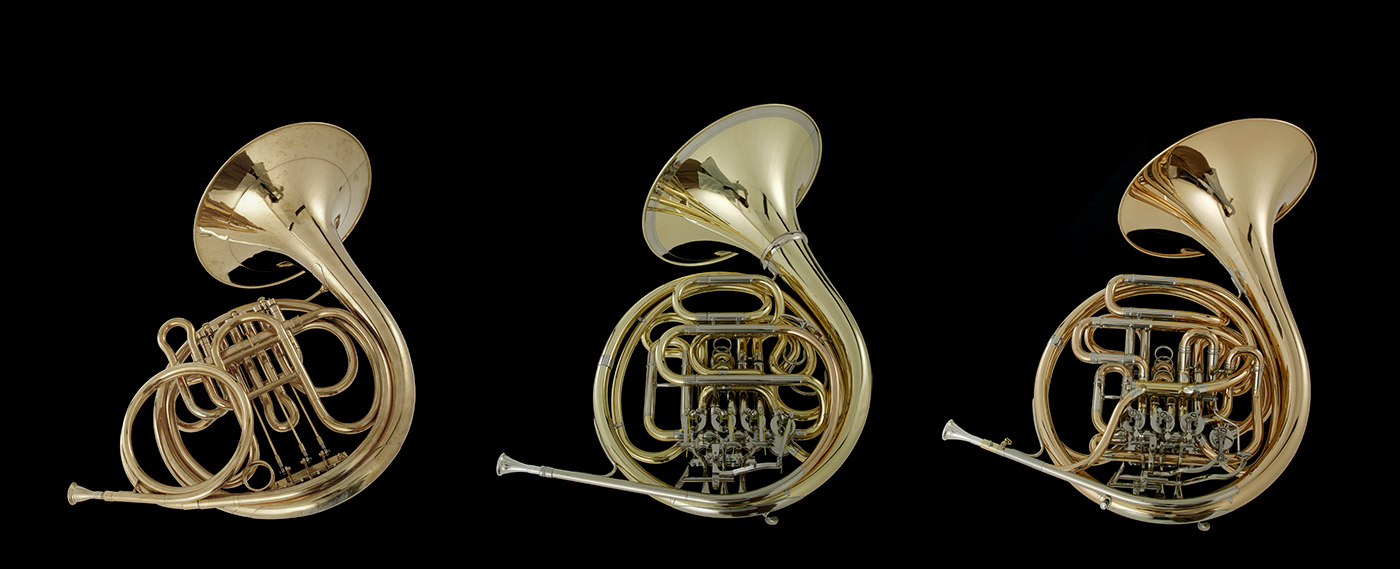
Comparison between horns (from left to right): Viennese horn, double (French) horn in F/Bb, triple horn in F/Bb/high f
In the initial phase of sound generation the Viennese horn requires more energy than the double horn; in fact, the air column to be vibrated is twice as long as that of the horn in high f (triple horn in F/Bb/high f). Passages with a large number of staccato notes are therefore very demanding.
In the upper register greater care must be taken than on other horns to apply the correct lip tension in order to avoid the dreaded "squeak", which must nevertheless be counted as one of the Viennese horn’s lovable "peculiarities".
The distinctive sound and playing characteristics of the Viennese horn are a result of its construction:
Compared to the double horn, the Viennese horn has a narrower bore: the cylindrical part of the bore has a diameter of about 10.8 mm compared to 11.5-13 mm on the double horn. Its bell and bell joint are also narrower. The result, as pointed out above, is a larger number of harmonics. The Viennese horn’s high harmonics rise more quickly than those of the double horn, even in fast crescendo passages, which means that the musician has a wider range of tone colors at his disposal.
The crook is a piece of coiled tubing, which is detachable on the Viennese horn but fixed on the double horn. By changing the crook, which accounts for nearly a third of the total tube length, the instrument’s character - i.e., its response, tone and intonation - can be altered.
The Vienna valve is a twin-piston valve. The position of the valves on the piston valve unit aids mellow formations of legato notes, which flow and change very smoothly. In fact, in fast legato passages the notes sound slightly blurred. On rotary valve instruments a short interval of noise separates the individual notes from each other, so that even in fast legato passages the impression of distinct notes is given.
The horns of the Middle Ages took many different forms, from the small horn carried on a strap over the shoulder to the military horn as tall as a man.
The most commonly used horns in the Middle Ages were:
The medium-sized cow-horn: because of its tremendous volume the cow-horn, which was actually made from a buffalo horn, was used for hunting.
The military horn: curved and made of metal this horn was nearly as high as a man. It had a louder and more booming note than any other horn and was therefore used for military purposes. Its successor is the Alpine horn.
The bugle: this was the smallest of all horns and was made either of animal horn or metal and was used by guards, sentries and shepherds. In courtly circles the more elegant version made of gold or ivory was used.
Instead of a mouthpiece, these instruments had an opening to blow into. Originally only a single note could be produced on the small horns and the first three naturals on the bigger ones. From about 1000 AD finger-holes, which first appeared in England, gradually increased the range of notes, following the example of pipes.
The first coiled horns, the direct forerunners of modern valve horns, were made in Europe, probably around the 12th century. Although coiled horns had already existed in early civilizations the knowledge of how to make them had been lost in Europe during the migration of peoples around 800 AD.
Baroque horns had cup-shaped mouthpieces which were either a flared extension of the tube mouth itself or a separate fitment to be attached. By half covering the finger-holes a chromatic scale could be played, and the technique of overblowing was also already in use. The art of "cornett playing" was already widespread. The cornett (German: Zink, Italian: cornetto, French: cornet à bouquin) had evolved from the medieval horns. The cornett had been improved considerably during the Renaissance and the baroque instrument had a thick, usually hexagonal curved tube made of wood and occasionally metal. It had seven finger-holes, which had keys on the larger instruments, and was blown through a cup-shaped mouthpiece. As the soprano of the trombone group the cornett was adopted by art music, especially in the works of J. S. Bach. The cornett cannot properly be called a brass wind instrument as we use the term today because its timbre was considerably thinner and did not possess the metallic character peculiar to modern brass instruments.
The large, single-coil hunting horn that was used in the 17th century (Italian: corno da caccia, French: cor de chasse) underwent its first technical development in France and for this reason became known as the French horn in England. This name was later used for a model of the modern valve horn.
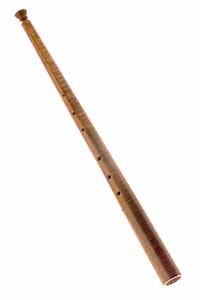
Straight Zink in C, Günther Körber (=signature), wood (Musikinstrumentenmuseum Schloss Kremsegg, Austria, collection Streitwieser)
In the middle of the 17th century, when the trumpet was already being used in art music, the horn was still seeing service as a signaling instrument for hunts and battles. One of the reasons for this was that coiled, circular tubes were very difficult to make. To all intents and purposes the hunting horn was a trumpet in the shape of a horn. The tubing was long and narrow and only very slightly conical. The instrument had the same series of natural harmonics as the trumpet of that time. The difference was that the horn’s tone did not possess the metallic shrillness of the trumpet.
The popularity of the hunting horn, the timbre of which was basically no different from that of the trumpet, was mainly due to its coiled tube, which made it a deep instrument that was easy to hold and well-suited for playing trumpet parts in the lower register - at that time the deepest trumpet (in low F) had a tube that was 3.86 m long - hardly practical!

Hunting horn in Eb with 3½ coils, Gaillard & Loiselet, Paris, after 1935 (Musikinstrumentenmuseum Schloss Kremsegg, Austria, collection Streitwieser)
In around 1680 the first hunting horn consisting of several coils and a conical tube made in one piece was constructed in Paris. Jean Baptiste Lully (1632-1687), who introduced important innovations in orchestral techniques (he expanded the string orchestra to five parts and was responsible for significant developments in the minuet and concerto grosso which he helped to international recognition, beside founding the French national opera), championed this improved horn and encouraged its widespread use. His efforts led to the adoption of the hunting horn by orchestras.
From the beginning of the 18th century the hunting horn was used, particularly by Bach and Handel, to play in a variety of registers, including the highest register up to the 16th natural, as was the trumpet. In the orchestra the horn was usually played by trumpeters, parallel to the other commonly used horn of the time, the cornett. By the middle of the 18th century the latter instrument had fallen out of favor, however, and was no longer used.
In around 1700 the hunting horn underwent a fundamental change, principally at the hands of the Leichamschneider brothers in Vienna. This new design imbued the instrument with a new quality of tone, and turned it into the true French horn. Michael and Johannes Leichamschneider widened the bore, thus darkening the timbre which up until then had resembled that of the trumpet, and creating a new, characteristic horn sound. The tubing was made more conical and was coiled four times, making the instrument easier to handle. In addition the new French horn was given tuning crooks, additional sections of tubing between the mouthpiece and tube which tuned it to a different pitch.
Further developments to the French horn carried out by the Bohemian hornist Joseph Hampel (1710-1771) from 1753 gave the instrument the structure and sound characteristics it possesses today. Hampel’s greatest innovation was the introduction of hand stopping for chromaticization.
Anton J. Hampel discovered that the notes of the natural harmonic series could be lowered by placing the hand in the bell, so that the gaps in the natural harmonic series could be filled. This technique gave the horn a certain chromaticism, although it goes without saying that the quality of these intermediate notes cannot be compared to the modern valve horn. For this technique, the bell was held facing downward, instead of on its side or facing upward as in the past, and the right hand was placed inside it. This produced a vast improvement in the sound quality, since stopping eliminated the shrillness and roughness of the horn’s timbre.
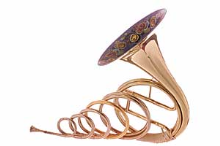
Hand horn, William Shaw, Red Lyon St Holborn, London, between 1783 and 1802
(Musikinstrumentenmuseum Schloss Kremsegg, Austria, collection Streitwieser)
The timbre was further refined by the replacement of the cup-shaped mouthpiece by a funnel-shaped one, which gave the horn the mellow and romantic euphony that characterizes the modern valve horn and contrasts so sharply with the strident metallic quality of the trumpet. In 1753/54 Hampel was also responsible for the construction of the first hand horn with slide crooks: on this horn the tuning slides were placed in the middle of the tube, which meant that different crooks could be inserted more quickly, a great advantage for orchestral playing.
In terms of sound, the new French horn was an entirely new orchestral instrument and even took over many of the roles which had previously been the province of the trumpet. Hampel’s hand stopping technique filled the gaps between the notes of the harmonic series and gave the French horn a certain chromaticism; however, the stopped notes were still far from perfect: in places they sounded very dull and could only be used as transitional notes and not for carrying a melody. To circumvent this problem, classical composers either called for several different tunings in one work (in his opera Don Giovanni from 1787, Mozart calls for no less than 36 changes in horn pitch), or they avoided stopped notes altogether. In the late classical orchestral repertoire there are very few notes that would have had to be played using stopping - one exception is the horn solo in Beethoven’s 9th symphony.
The last crucial development in the evolution of the horn to its modern form was the invention of valves. In 1814 Heinrich Stölzel from Berlin presented a valved horn, and in 1818 he and Friedrich Blühmel were granted a patent for a piston valve. Since then the valve horn has undergone permanent improvements to its construction and sound, because the quality of the sound of the first valve horns was nowhere near as good as that of the natural hunting horns. It is for this reason that the valve horn was initially rejected - as was the valve trumpet later on - or used in the orchestra only in combination with the natural horn. Carl Maria von Weber (1786-1826), Richard Wagner (1813-1883) in his early works and Johannes Brahms (1833-1897) all preferred the sound of the natural horn. One of the first composers to write for the valve horn was Robert Schumann (1810-1856), who in 1849 wrote his Adagio and Allegro for horn in F and piano and his Concert piece for 4 horns and orchestra for the valve horn.
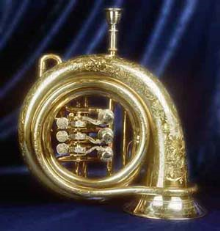
Czar horn, Joseph Schediva, Odessa, around 1884. This gold-plated horn with engravings (flower ornaments, Russian two-headed eagle and St. George) was built specially for Czar Alexander III
(Musikinstrumentenmuseum Schloss Kremsegg, Austria, collection Streitwieser)
The structure of the modern valve horn is still basically that of the triple-valved horn, which emerged in 1830. It was the addition of the valves that gave the instrument a full chromatic range.
Toward the end of the 19th century the German instrument maker Fritz Kruspe produced the first double horn in F/Bb. From the middle of the 20th century this horn, equipped with rotary valves, gained greater acceptance than models with piston valves, and today the double horn in F/Bb is the most widely used horn in orchestral music. It is joined in most cases by horns in F, in high Bb and the triple horn in F/Bb/high f.
The horn is a transposing instrument and unlike the trumpet sounds deeper than written in all tunings.
The modern horn is notated in F; in bass clef and treble clef it is written a fifth higher than it sounds.
Since the 1920s the practice of writing in concert notation for all instruments has become widely accepted, notably in the works of the Viennese School (Arnold Schoenberg, Alban Berg, Anton von Webern) and in serialism. The practice was introduced to make it easier to read complex scores, and there are numerous examples in 20th century literature. Stylistic developments that favored equal status for all twelve chromatic tones and avoided building around a particular key may well have been further factors that led to the use of the same notation for all instruments.
Unlike other transposing instruments such as the clarinet, the horn part - along with the trumpets and timpani - has always been written without key signature at the beginning of the staff. This tradition dates back to the beginnings of orchestral music and is still practiced today. Accidentals were extremely rare and were written into the score.
One peculiarity of horn notation is the signs used to indicate open and stopped notes: o = open, + = stopped.
Because the horns blend very well with the woodwinds, the horn part is found immediately below the woodwinds in the score, a place which would logically be occupied by the trumpet as the soprano instrument in the brass section.
In many 19th century scores the horn part, which was written in bass clef for low notes, was written a fourth lower than it sounded. This old style of notation - which was known as "high bass clef" - is no longer usual today. In new editions of old scores the horn part is generally rewritten so that the horn in F always sounds a fifth lower.
In line with the possibilities offered by the natural horn, only notes from a single natural harmonic series were available. Other pitches were very rare, because they could only be produced by stopping which resulted in a distortion of the timbre. The pitch of the horn was indicated in the score and the part was notated in C. Consequently most of the notation for the horn part corresponded to the natural harmonic series in C. Accidentals appeared only very rarely and were written into the score.
In classical symphonic music, a pair of horns was generally used for pieces in a major key, whereas two pairs were used for pieces in a minor key. This was done for harmonic reasons, since it was the only way to produce the second subject in the parallel major key.
Classical sonata movements really consist of two "themes" or "subjects". These can be compared to two more or less active characters. The first "theme" is of course always in the principal key (tonic), the second in the most closely related, which is the one a fifth above it, the dominant. This applies to pieces in a major key. In pieces in a minor key the second theme is a third higher, in the parallel major key. But because the dominant in minor is in major on account of the leading note a "chromatic conflict" arises which could only be solved by one or two pairs of natural horns in different pitches. One of the horn’s main tasks was to support all the harmonically relevant tones (see for example W. A. Mozart, Symphony in G Minor, K.V.550).
In the course of time the two pairs of differently-pitched horns became standard in orchestration, as a result of which new harmonic possibilities - e.g. in modulations - were opened up for the instrument.
Today, four horns are standard in performances of the classical-romantic repertoire and their notation is written in pairs: the 1st and 3rd horns play the high part, the 2nd and 4th the low one. Two ways of summarizing the horn parts have gained acceptance:
1. The notation of the high (1st + 3rd) and low (2nd + 4th) horns is interlocking (Bruckner, Brahms and Wagner use this interlocking notation).
2. The high (1st + 3rd) and low (2nd + 4th) horns are notated on the same staff. Gustav Mahler, for example, uses this notation. Especially when one writes for 6 or 8 horns this usage is more convenient.
The way the horns are summarized depends in no small measure on the context.
Note
The modern hornist must therefore answer the following questions before he begins to play:
- Is his part written for an F horn?
- Is his part written in the modern bass clef or the old high bass clef?
- Is the instrument playing the part (nowadays a horn pitched in F) pitched in the same tuning as the written part? (If not, the musician must transpose accordingly. For example, if a part written for a horn in E is to be played on a horn in F the hornist must transpose to F. If a part written in F is to be played on a horn in Bb - an instrument used only rarely today - transposition is also necessary.)
The horn in F has a range from B1 - F5 (sounding)
- Lower register: B1 - D3
- Middle register: Eb3 - Eb4
- Upper register: E4 - F5
Whereas the 1st natural is not used on the F horn (although some hornists can play it) it is very much part of the range played on the horn in high Bb and speaks well on this instrument.
The F horn’s range begins with the 2nd natural and rises to the 16th, although the naturals 12 to 16 are very difficult to play.
The instrument’s natural harmonic series can be lowered by six half steps by activating the valves, i.e. by lengthening the tube step by step.
Every activation of a valve produces a lower natural harmonic series, so the hornist has a total of seven natural harmonic series at his disposal, from which he can produce every chromatic pitch by means of overblowing. The activation of the 2nd valve, for example, lowers the horn’s pitch by a semitone, making it a horn in E; by pressing the 1st valve the player has an Eb horn, and so on.
Fingering:
As on the trumpet there are seven different fingerings on the horn. Each fingering lowers the natural harmonic series by a semitone:
When the lowest note is played (B1 pitch = 7th fingering) the horn’s tube length increases from 3.86 m to 5.5 m. The fact that a 5.5 m long air column has to be vibrated to sound this note means that response is harder in the lower register than in the middle and upper registers. The low notes have a low frequency and correspondingly long vibrations. In the narrow tube the amplitude cannot develop in proportion to the long vibrations, which gives the forced notes in the low register a rather rough sound.
Leaps up to the higher range can be problematical because the notes of the natural harmonic series are very close together at this level, so that even the slightest change in lip tension alters the pitch (sound production is also influenced by factors such as the instrument’s temperature or fluid in the tube). It is far easier for the hornist to attack a very high note abruptly than it is to leap from a low note to a high one.
Due to the large range of the horn, orchestra hornists specialize either in the high register (from the 4th natural) or the low register (to the 12th natural) and are consequently known as "high hornists" (1st and 3rd hornist) or "low hornists" (2nd and 4th hornist).
In the middle register, and especially in the upper register, every one of the horn-playing techniques can be applied with ease. Difficulties arise with leaps to the naturals from the 13th upward. The deepest notes (B1-E2) develop only very slowly and ponderously.
Easy performance of scales, leaps etc., slow response of the lowest notes.
A microtonal pitch fluctuation possible in passages at any tempo and at all dynamic levels; vibrato can be played in virtually any context, from pp to ff and from slow to fast. On the horn, this technique is largely ignored in the classical repertoire, but in contemporary music every kind of vibrato is used.
Sforzando
Forced, short attack followed by a rapid reduction in tone intensity.
Sforzandissimo
Forced, short attack with continuance of tone intensity.
Fortepiano
Rapid dynamic reduction from forte to piano. One of the typical horn sounds and often called for. The effect is of distance, echo and drama. Main musical themes are very often allocated to the horn, which introduces them fortepiano and attracts the audience’s attention by doing so - a kind of signal, since the horn was originally a signaling instrument. (Beginning of the 5th movement of Gustav Mahler's 5th Symphony.)
Easy to play in the middle and upper registers, problematical in the low register and at the very highest pitch.
Easy to play in the middle and upper registers, problematical in the low register and at the very highest pitch.
Playable in the middle and upper registers.
Rarely called for in earlier works, mainly found in 20th century works, e.g., Igor Stravinsky’s (1882-1971) "The Rite of Spring". Glissando can be played best in the upper register where the partials are close together.
The whole note trill is easier to perform than the half note trill (only using the old stopping technique!). Most effective between G#3 and C5.
Lip trills are also possible on high notes.
Stopped notes are notated in two ways: either with the word stopped, or with the sign +.
The musician presses his right fist into the bell, filling it completely. This has the effect of projecting the sound not through the bell but through the vibrating tube, which darkens the timbre and raises the pitch by a minor second. The technique also alters the directional characteristics of the sound, which now appears to be coming from far away, creating the impression of wide open spaces: the sense of space is changed.
A typical and very effective technique on the horn is the playing of open and stopped notes in rapid succession (open-stopped effects, o - +).
Increased lip tension and a very forced but controlled attack cause the tube to vibrate strongly. Popular horn technique, used to demonstrate strength, authority etc. Spurned as a trumpet technique.
Notation: + = sign indicating muted notes)
Muted notes are notated in two ways: either with the word muted, or with the sign +.
Instead of the hand a mute is placed in the bell. The effect on the sound is much the same as with hand-stopping, unless the musician uses a non-transposing mute, in which case the pitch does not change.
Full, warm, velvety, clear, distant, mellow, metallic.
The sound is homogeneous, only the deepest notes sound a little more muffled and ponderous.
Most effective played piano, where the notes are very mellow and sonorous. Well-suited as bass in horn chords or woodwind chords. Also very effective as solo bass. Ideal for the performance of thematic tasks, for example in the 3rd movement of the 7th symphony by Ludwig van Beethoven (1770-1827), where the sustained horn notes are extremely sonorous and mellow.
Forte notes sound a shade less powerful and expressive than in the upper registers. When forced they take on a slightly rough tone.
Middle register Eb3 - Eb4Full and resounding. Piano notes very mellow. Forced notes can sound mellow or coarse and tempestuous. Creates a more sober impression than the upper register.
Upper register E4 - F5 Soft as velvet, bright and very intense, brilliant. This characteristic horn sound develops best around C5, as the horn quartet in the overture to Weber’s "Freischütz" demonstrates.Forced, the high horn notes are very bright and powerful but with relatively little shrillness.
Note
The horn blends with all the instrument groups in the orchestra better than any other instrument.
If the horn is used in combination with other brass instruments the sound becomes thicker: cup and funnel-shaped mouthpieces mutually cancel out their characteristic sounds.
Because four horns are usually used in the orchestra, chords are often written for four horn parts.
The sound of the tuba as the median between the sounds of the cup and funnel-shaped mouthpieces blends very well with the horn.
In chord combinations of horns with trumpets and trombones the instruments’ dynamics must be carefully balanced: Played piano all brass instruments sound at more or less the same volume; but a horn played forte has only about half the volume of a trumpet or trombone played forte. These discrepancies can be compensated for by using proportionate dynamic instructions: trombones or trumpets pp = horn p. A trumpet or trombone played forte corresponds roughly to two horns played forte.
The combination of horn and oboe only produces a homogeneous sound if the horn is stopped or muted.
The horn/bassoon combination is very effective when the bassoon plays the bass part. Blending is also very good with the bass clarinet when the latter plays pp or p.
Framing the woodwinds with horns is not recommended, because the latter smother the former.
A particularly pleasing effect is achieved when the muted horn is played with muted strings, as in Richard Strauss’s opera Salome.
Note
In closed chord groups, for the playing of melodic, harmonic or rhythmical passages, or as a solo instrument, in unison with several other horns for the evocation of distinct, dominant themes; the horn section can be assigned a number of specific tasks (performance of filling-in parts, counterpoint parts or sections of these, bass parts, tremolos or trills, figurations etc.).
The horn frequently carries the main musical theme.
For several centuries the horn served as a signaling instrument in many areas of daily life: shepherds blew it to gather their flocks, inhabitants of Alpine regions used it to send messages from one peak to another, messengers blew to announce their arrival, hunters communicated with each other using horn signals, and last but not least the horn was, of course, indispensable in battle. It is hardly surprising that this multiplicity of functions gave the instrument huge significance as a symbol of communication: the horn is still used in many European countries as a symbol of the mail service, and as a symbol of hunting and the forest (the literal meaning of Waldhorn is "forest horn").
In addition to this the horn has always been a symbol of status or the independence of a community (e.g. as a symbol of knighthood). This is shown by elaborately decorated horns made of precious materials such as ivory or silver that had originally been brought to Europe from Byzantium. In Renaissance times the horn became a status symbol among the aristocracy, and especially a symbol of the splendor of the aristocracy’s hunting expeditions.
Thanks to the instrument’s natural sound characteristics the forest imagery developed further until the horn came to symbolize the expanses of nature, wide open spaces, (unsatisfied) yearning and solitude. With the more widespread use of the valve horn from the end of the 19th century the soft, dignified and majestic sound of the horn began to epitomize romantic and sentimental feelings.
Not least since Gustav Holst’s The Planets does the sound of the horn also conjure up visions of space, the infinite universe, mankind’s yearning to explore its vastness and push forward into new dimensions. Today, this symbolism is used very often in film music.
In the 20th century the horn was used to express a wide variety of sometimes contradictory emotions, from the pain of parting to the joy of arrival, from the yearning for peace and security to feelings of triumph.
Carl Maria von Weber
- Der Freischütz (1821)
Richard Wagner
- Prelude to Rheingold (1854)
Wolfgang A. Mozart
- Horn concertos
Ludwig van Beethoven
- 3rd symphony (Eroica) (1803)
- 9th symphony (1824)
Johannes Brahms
- 2nd symphony (1877)
Gustav Mahler
- 2nd symphony (1894): 10 horns
Richard Strauss
- Horn concertos
- Till Eulenspiegels lustige Streiche (1895)
Joseph Haydn
- Divertimento Hob. II:15, for 2 oboes, 2 horns, 2 bassoons (1760)
- Divertimentos Hob.II: 21 and 22, for string quartet and 2 horns (before 1765)
Wolfgang A. Mozart
- 6 divertimentos between KV 213-289, for 2 oboes, 2 horns, 2 bassoons (1775-1777)
- Divertimentos KV 247 (1776), KV 287 (1777), KV 334 (1780),
Ein musikalischer Spaß ("a musical joke") KV 522 (1787), all for string quartet and 2 horns - Horn quintet KV 407 (1782)
- Wind octets KV 375, 388 (1782)
- Quintet for piano and wind instruments KV452 (1784)
Ludwig van Beethoven
- Wind octet op. 103 (1793)
- Horn quartet op. 81b (ca. 1795)
- Wind sextet op. 71 (1796)
- Quintet for piano and wind instruments op.16 (1797)
Francesco Danzi
- Horn quartet op. 15 (ca. 1798)
Franz Schubert
- Wind octet D 72 (1813)
Louis Spohr (1814)
Anton Reicha (1817)
Franz Schubert (1803, 1824)
A. Reicha
- String quartet with horn (1826)
Johannes Brahms
- Trio for violin, horn and piano op. 40 (1865)
Leoš Janácek
- Mladi (wind sextet, 1924)
Arnold Schönberg
- Wind quintet op.26 (1924)
Paul Hindemith
- Kleine Kammermusik op. 24 (1922)
Matyas Seiber
- Serenade (wind sextet, 1925)
Henri Badings
- Quartet for 2 trumpets, horn and trombone (1947)
György Ligeti
- Zehn Stücke (1968)
Elliott Carter
- Brass quintet (1974)
Robert Schumann
- Adagio und Allegro op. 70 (1849)
Ludwig van Beethoven
- Sonate op. 17 (1800)
On this page
- Stopping and Valves
- Vienna valve
- Rotary valve
- Stopping valve
- Stopping
- Distinctive features of the Viennese horn
- Why is the Viennese horn harder to play?
- Bore
- Detachable F crook
- Valves
- History 1 - early to baroque
- The Middle Ages - from a single note to a scale
- The Baroque period - from hunting horn to orchestra instrument
- History 2 - classical to modern
- Classical period - stopping technique renders natural horns chromatic
- The Romantic period: The era of the valve horn begins
- Notation
- Modern notation
- Concert notation
- No key signature at the beginning of the staff
- Older notation
- Range
- Sound production
- Playing Techniques
- General
- Single Tonguing
- Vibrato
- Sforzato
- Double tonguing
- Triple tonguing
- Flutter tonguing
- Glissando
- Trills
- Stopped
- Open
- Brassy
- Mute
- Legato
- Sound characteristics
- Sound Combinations
- Horn + brass instruments
- Horn + woodwinds
- Horn + strings
- Symbolism
- Repertoire (selection)
- Operas
- Symphonic works and concertos
- Chamber music
- Solo works
